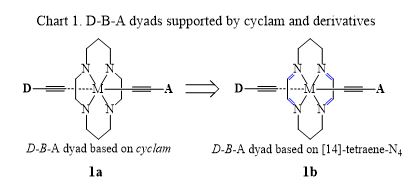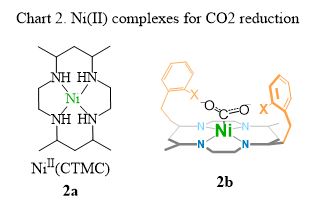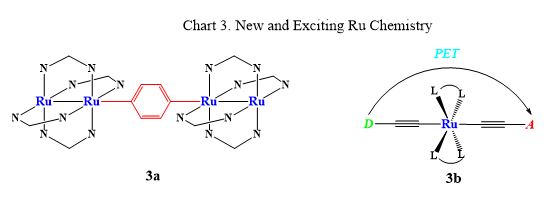Tong Ren

- Professor | Inorganic Chemistry
- Email: tren@purdue.edu
- Phone: 45466
- Office: 5130A BRWN
- Professor Tong Ren's individual homepage
Our laboratory has a long-standing interest in conjugated organometallic and coordination compounds that may exhibit interesting electronic and opto-electronic properties. Early on, our efforts focused on linear conjugated molecules based on diruthenium alkynyls, and prototypes of molecular wires, molecular switches and charge injection memory devices have been demonstrated (Organometallics, 2005, 24, 4854). Compelled by the desire to develop sustainable materials and catalysts, our focus has shifted to 3d metal (Cr, Fe, Co and Ni) compounds supported by cyclam and its derivatives (see publications #183 and #197 on our webpage.) Many novel 3d metal alkynyl compounds have been realized, and photo-induced electron transfer processes in donor-bridge-acceptor (D-B-A) dyads have been probed with sub-ps transient spectroscopy (Section 1 below). New Ni(II) cyclam' ( C -substituted cyclam) complexes have been prepared, with some of them exhibiting significantly improved CO 2 reduction efficiency over the classic Ni(cyclam) (Section 2). Additionally, on the basis of our recent discovery of diruthenium aryl compounds, there has been a renaissance of Ru chemistry (Section 3).
1. Conjugated 3d Metal Complexes Supported by Cyclam and Derivatives
Rich coordination chemistry of [M(cyclam)] (cyclam = 1,4,8,11-tetraazacyclotetradecane) has been explored by many for the interest of bioinorganic modelling. Yet, the organometallic chemistry of [M(cyclam)] remains largely uncharted territory. Our laboratory has succeeded in the preparation of both
trans-
[M(cyclam)(C
2
R)
2
]
+
(M = Cr, Fe and Co) and wire like {[Co(cyclam)]
2
(μ-C
2m
)}
2+
. More importantly, stepwise alkynylation methods have been developed for the
trans-
[DC2-M(cyclam)-C
2
A)]
+
type complexes (Chart
1
,
1a
), where D and A represent photo-active electron donor and acceptor, respectively. With M = Co(III), the photo-induced electron transfer processes in the dyad were probed with fs transient absorption and time resolved infrared spectroscopies, and a charge separated (CS) state (D
+
-B-A
-
) was identified with a lifetime of
ca
. 10 ps. The relatively short CS lifetimes in the Co based D-B-A were attributed to quenching by a low lying Co(III) centered triplet – a so called ligand field (LF) state - which is the bottleneck for the development of 3
d
metal photo-sensitizers.

A serendipitous discovery during the study of Fe-HMC complexes revealed that the tetra-imine derivatives of cyclam afford 3
d
metal complexes (M = Fe and Co) with exceptionally large ligand field splitting, which resulted in a substantial stabilization of the metal-to-ligand charge transfer (MLCT) states relative to the LF states. Currently, our efforts focus on the syntheses of the type
1b
D-B-A dyads and exploration of the dynamics in these complexes using fs transient absorption and fs XANES spectroscopic techniques.
2. Electrochemical and Photo-electrochemical reduction of CO 2 with Ni(II) cyclam’
Ni(II) and Co(III) complexes of tetra-aza macrocycles, especially Ni(cyclam), have been the gold standards of homogeneous catalysts for electrochemical reduction of CO
2
. Leveraging our experience in synthesizing
C
-substituted cyclams (cyclam’), we developed a number of Ni(II) cyclam’ complexes, and found that while aryl substituents had deleterious effects on the efficiency of CO
2
reduction, alkyl substituents resulted in Ni(II) complexes (e.g. Ni(CTMC),
2a
in Chart 2) with considerably enhanced efficiency. Current efforts are directed towards further modification of Ni(II) catalysts through second coordination sphere engineering (
2b
, Chart 2), and photo-reduction of CO
2
by the combination of Ni(II) cyclam’ and novel photosensitizers.

3. Renaissance of Ru chemistry
We discovered recently that Ru
2
(
ap
)
4
Cl (
ap
= 2-anilinopyridine) undergoes metathesis reaction with LiAr to yield Ru
2
(ap)
4
Ar, a new class of Ru
2
compounds. This chemistry has been extended to other Ru
2
compounds, and Ru
2
(
ap
)
4
Ar was shown to react with a series of isoelectronic diatomic ligands Y (CO, CN- and HC≡C
-
) to give
trans
-Y-Ru
2
(
ap
)
4
Ar. Currently being explored is the possibility of bridging two Ru
2
(ap)
4
units with arylene ligands (
3a
in Chart 3), which may mediate Ru
2
- Ru
2
electronic couplings. Also of interest are the D-B-A dyads based on the Ru(L-L)
2
unit (L-L are neutral chelating ligands) (
3b
in Chart 3), and photo-induced electron transfer processes therein.

Education
- Ph.D., Texas A&M University, 1990
- Post-Doctorate, Massachusetts Institute of Technology, 1993